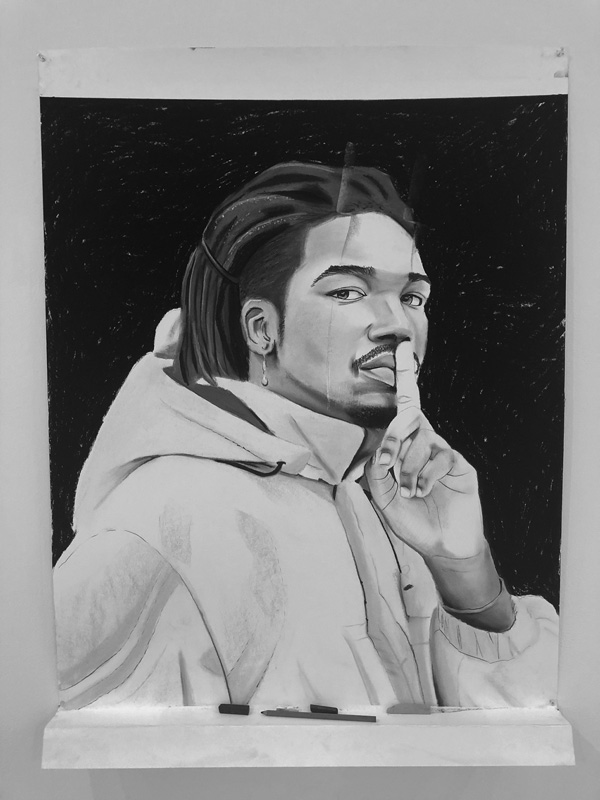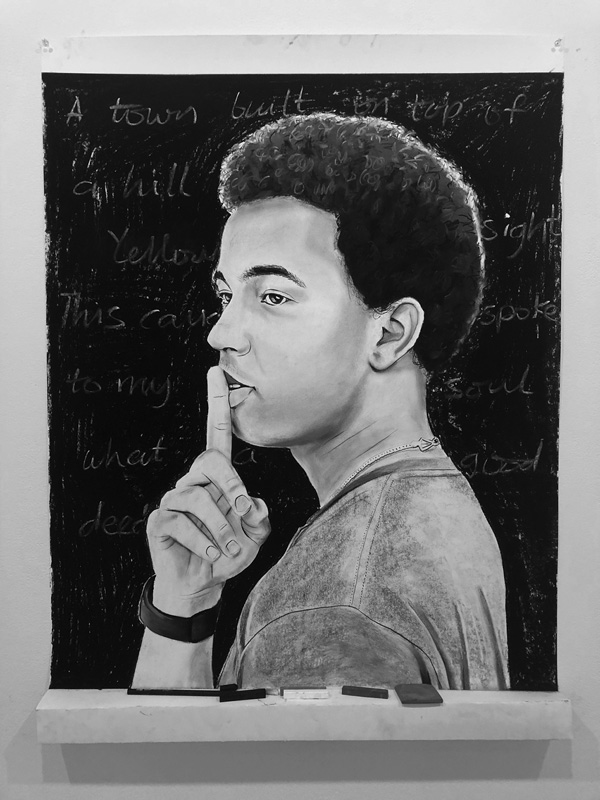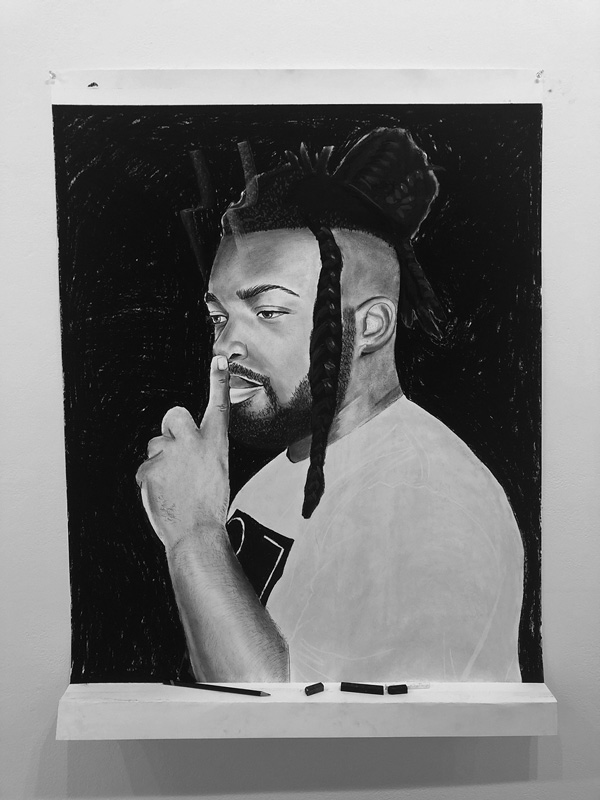Arts & Culture July 2022
Portraits of a community
Exhibit reflects artist’s yearlong residency in North Adams



Conrad Egyir’s new exhibit, “Travelogue,’ which opened in June at Gallery 51, includes his portraits of, from left, Odiase Williamson, Winston Wall and Delano Mills, along with others he met in the course of his artist residency at MCLA. Courtesy photos
By KATE ABBOTT
Contributing writer
NORTH ADAMS, Mass.
A man meets your eyes with confident humor, alive with his own thoughts.
A woman near him is listening to music, a father singing to his daughter:
“If we lay a strong enough foundation,
we’ll pass it on to you — we’ll give the world to you …”
Across from her, a young man is standing, absorbed in words spoken by a son to his mother and father.
“You thought I didn’t know you.
You thought I didn’t know your worth …”
They are all people who have lived and worked in North Adams this year — and they are all works by an internationally known artist with growing recognition across the country.
Conrad Egyir celebrates a community in his new summer exhibit, “Travelogue,” at the Massachusetts College of Liberal Arts, with a sense of triumph and joy. The show opened June 10 and runs through Sept. 9 at the college’s Gallery 51 on Main Street.
Egyir has journeyed widely and won recognition for his work — as an artist working in Detroit, represented in San Francisco and born in Ghana. The new show has grown out of his time in a yearlong artist and teaching residency, the first of its kind at MCLA. He has gathered together people he met over the past year in charcoal drawings and sculptural installations and portraits painted in vivid color.
The works show MCLA students and artists in residence — the community Erica Wall, MCLA’s director of arts and culture, has brought together since she came to the college in the fall of 2019. The show represents a culmination of her work here, as she leaves this summer for a new position at Colby College.
An exaltation of artists
Wall appears in one these portraits, wearing a bright patterned jacket and surrounded by living plants. Egyir sees her as a sage, he said, and in his painting he invokes a source of wisdom — a supernatural, powerful entity.
“I have this reverence for her,” he said.
Around her, Egyir has painted the creative forces she has brought into North Adams even in the height of the pandemic.
Genevieve Gaignard, a nationally acclaimed artist in photography, film and multimedia, came for a residency in the spring of 2020 and worked with her students virtually through the college’s pandemic shutdown.
At the foot of her painting, Egyir has Polaroid and film reel cameras to embody her experiences. He has experimented in this show with expanding into physical space. He has had room and freedom in the residency, Wall said, and has been intimately involved in the curation of his own show from the beginning. She said she found it exciting to work with him as he explores new forms.
Wall has grown the artist residency program to a total of three artists this year, so that Egyir has had fellow artists to work with in each semester.
In this show, Nathaniel Donnett, who joined Egyir in residency at MCLA this spring, looks out from a mountain road under a blue sky, surrounded with the kinds of books they shared in their time here together. Donnett is an artist based in Houston with work on view across the country, and he will have a solo show here in the fall.
“Nathaniel was very big on reading, literature,” Egyir said. “I learned a lot from him. … Every conversation we had, he would make sure to throw out [the names of] two or three books he has read, and I would get them right away.”
West Coast photographer and filmmaker Joshua Ross stands beside Donnett with his head back, wearing vivid yellow -- a color Ross would never wear, Egyir said laughing, but it felt right to him here.
Ross is “someone who’s always radiating joy and happiness and sunlight whenever you engage with him in a conversation,” Egyir explained. “So even though he’s always wearing black, he exudes that energy.”
They shared meals and music together while they were working together.
“He and I would share playlists during the residency,” Egyir said, “to keep ourselves going in the studio.”
Savoring sound and silence
The music Egyir is listening to can weave through his images. In two of his charcoal drawings, he has laid words behind the people, filling the space around them. Aaron Burr is singing to his newborn daughter in Lin-Manuel Miranda’s “Hamilton,” and Chance the Rapper is recalling his childhood in “Town on the Hill.”
In a series of four drawings, Egyir has highlighted his students, his student artist assistants Odiase Williamson and Delano Mills, and Wall’s son Winston, and in each one the subject stands in the center, relaxed and in charge, holding one figure to his lips.
“It’s about stillness,” he said, “and being confident in who you are and what you know, and embracing that and holding that in.”
They share an internal silence, but an affirming one.
“They are not being shut down by outside walls where they have to go into hiding,” Egyir said. “If you pay attention, they have a smile behind that — there’s a finger on the lip and a reinforcement of the smile behind the finger. It’s more an internal joy, calm and tranquility, knowing even though they are silent, they are silent for good reason.”
Some of these themes and gestures have run through his work for years, Egyir said. He will get to know the people in his paintings. He will photograph them and talk with them, and from those conversations he will guide how they move and hold themselves, helping them to draw out expression in their faces and bodies.
But he said the depth of the conversations he has had here have become a new way of working for him.
Egyir first became known for monumental works, vividly colorful murals that hold stories and symbols, in his last year of graduate school, Wall said. She has known him since then — since his senior thesis caught national attention and the Jessica Silverman Gallery in San Francisco signed him on. His career skyrocketed. Coming to MCLA for the past year has given him time and space to decide where he wants to go.
He said he has found his process changing and deepening during his residency here. He let this show unfold over time, rather than planning in advance.
In the past, when he photographed someone who came to model for him, he was not trying to tell their story. He would have an idea, and he would shape his images to tell it.
“I’d spend three to six months on the research,” he said. “Most of my work back then was centered around using historical or political or West African narratives in a more contemporary, Americanized fashion. I would talk about empathy, citizenship, migration, sovereignty.
“It was different here. I didn’t come in here with the same language. I just wanted to focus on my time here, the time I spent here, the people I was spending time with. I was listening to their stories, and painting, and having them sit so I could paint them or draw them.”
He described his experience at MCLA as “slowing down and taking time to breathe, away from the fast-paced work in Detroit, and just being part of this community.”
Making a gathering place
As he got to know the people around him in North Adams, Egyir felt in them a strong need for community.
He was teaching painting and drawing, and trying to give his students the space and resources for originality. He brought them art supplies, he said, and had them experiment with materials they hadn’t had a chance to work with before. And he tried to make the studio a place where they could open up and experiment.
“I was giving them the push,” he said. “But I also had a lot of grace with them. … I think I was leading by example. I showed them my work … the ups and downs that I had to go through, the changes in the work over the years.”
And then the whole MCLA community was shaken at the core. Early in the spring, a student committed suicide, he said. She was a student of color. Her loss set an ominous cloud over the whole campus, and he felt it around him.
“Experiencing this, I was very conscious of how I was engaging with students in the classroom,” he said.
He held the shared sense of pain and the community’s grief in many conversations in his studio as well. When Black students came in to sit for photographs and sketches, he had the chance to talk with them.
“I just wanted to make sure they were being heard, they were being felt, they felt safe, they felt at home, and they were also engaging with the other Black students around campus,” he said. “I found out that most of them were in isolation. … They might have had a friend or two, but there wasn’t much sense of community.”
They often came in with stoic expressions, he said, holding sadness behind careful control. And in each session, during the conversation, he would see a light growing in them. He has wanted to help them to feel the confidence he sees in them in those moments, and to help them come together and find each other. He hopes his show can help to give the community that kind of gathering space.
As thankful as he is to have the show open now, Egyir said he felt some sadness that it has opened after the semester is over, when he is finished with the residency and heading back to the Midwest. Initially this show was going to go up while he was here, and while school is in session. Now many people have left for the summer.
The show will run until the first two weeks of school in the fall, and he hopes his students will see it then.
“This whole sense of community,” he said, “gathering everyone back here in this space to see their portraits rendered with such countenance — that was something I was hoping to see.”
